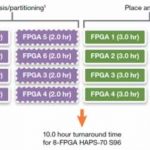A few months ago, I wrote about Corigine and their MimicPro FPGA prototyping system and MimicTurbo GT card solutions. That article went into the various features and benefits of the two solutions, with the requirements for next-generation prototyping solutions as the backdrop. You can access that article here. At 250+ employees,… Read More
Tag: haps
High-Performance Natural Language Processing (NLP) in Constrained Embedded Systems
Current technology news is filled with talk of many edge applications moving processing from the cloud to the edge. One of the presentations at the recently concluded Linley Group Fall Processor Conference was about AI moving from the cloud to the edge. Rightly so, there were several sessions dedicated to discussing AI and edge… Read More
Prototyping GPUs, Step by Step
FPGA-based prototyping has provided a major advance in verification and validation for complex hardware/software systems but even its most fervent proponents would admit that setup is not exactly push-button. It’s not uncommon to hear of weeks to setup a prototype or of the prototype finally being ready after you tape-out. … Read More
More on HAPS hybrid prototyping for ARMv8 with Linaro
A few weeks ago we previewed a Synopsys webinar describing how they are linking the ARM Juno Development Platform with the HAPS-80 and HAPS ProtoCompiler environment. I’ve had a look at the archived event and have some additional thoughts.… Read More
Webinar alert – Hybrid prototyping for ARMv8
All the talk about ARM server SoCs has been focused on who will come up with the breakthrough chip design. Watching trends like OPNFV develop suggests the big breakthrough is more likely to come on the ARMv8 software side. How do you quickly validate ARMv8 software when you don’t have the exact ARMv8 SoC target?… Read More
Time-saving modules expand Prototype Ready family
A big advantage of FPGA-based prototyping is the ability to run real-world I/O at-speed, significantly faster and more accurately than hardware emulation systems typically requiring a protocol adapter. Dealing with real-world I/O means more thorough verification of SoC integration, and the opportunity to optimize systems… Read More
Debugging is the whole point of prototyping
The prototype is obviously the end goal of FPGA-based prototyping, however success of the journey relies on how quickly defects can be found and rectified. Winning in the debug phase involves a combination of methodology, capability, and planning. Synopsys recently aired a webinar on their HAPS environment and its debug ecosystem.… Read More
A Brief History of FPGA Prototyping
Verifying chip designs has always suffered from a two-pronged problem. The first problem is that actually building silicon is too expensive and too slow to use as a verification tool (when it happens, it is not a good thing and is called a “re-spin”). The second problem is that simulation is, and has always been, too slow.
When Xilinx… Read More
FPGA Prototyping: From Homebrew to Integrated Solutions
Years ago, when FPGA prototyping started, there were no solutions that you could go out and buy and everything was created as a one-off: buy some FPGAs or an FPGA-based board, and put it all together. It was a lot of effort, nobody really knew in advance how long it would take, there was very limited visibility for debug and the whole … Read More
More FPGA-based prototype myths quashed
Speaking of having the right tools, FPGA-based prototyping has become as much if not more about the synthesis software than it is about the FPGA hardware. This is a follow-up to my post earlier this month on FPGA-based prototyping, but with a different perspective from another vendor. Instead of thinking about what else can be done… Read More










